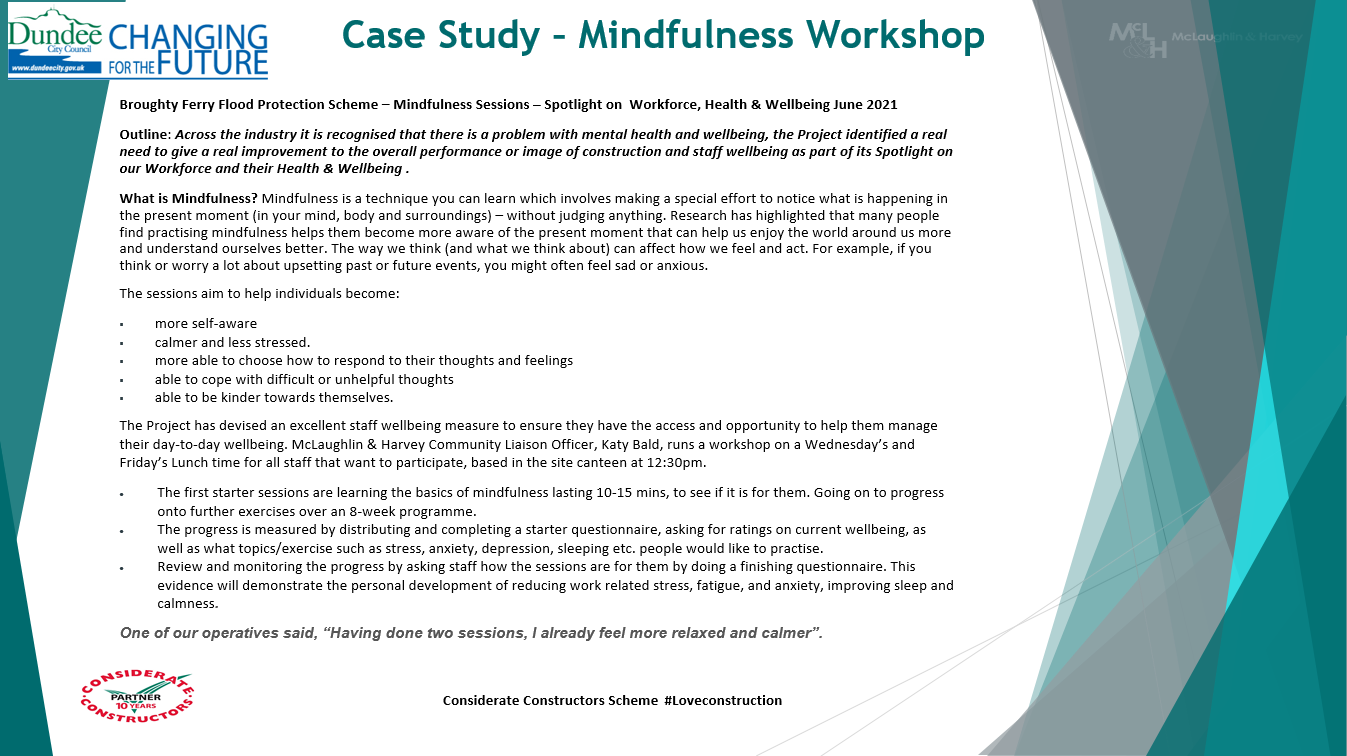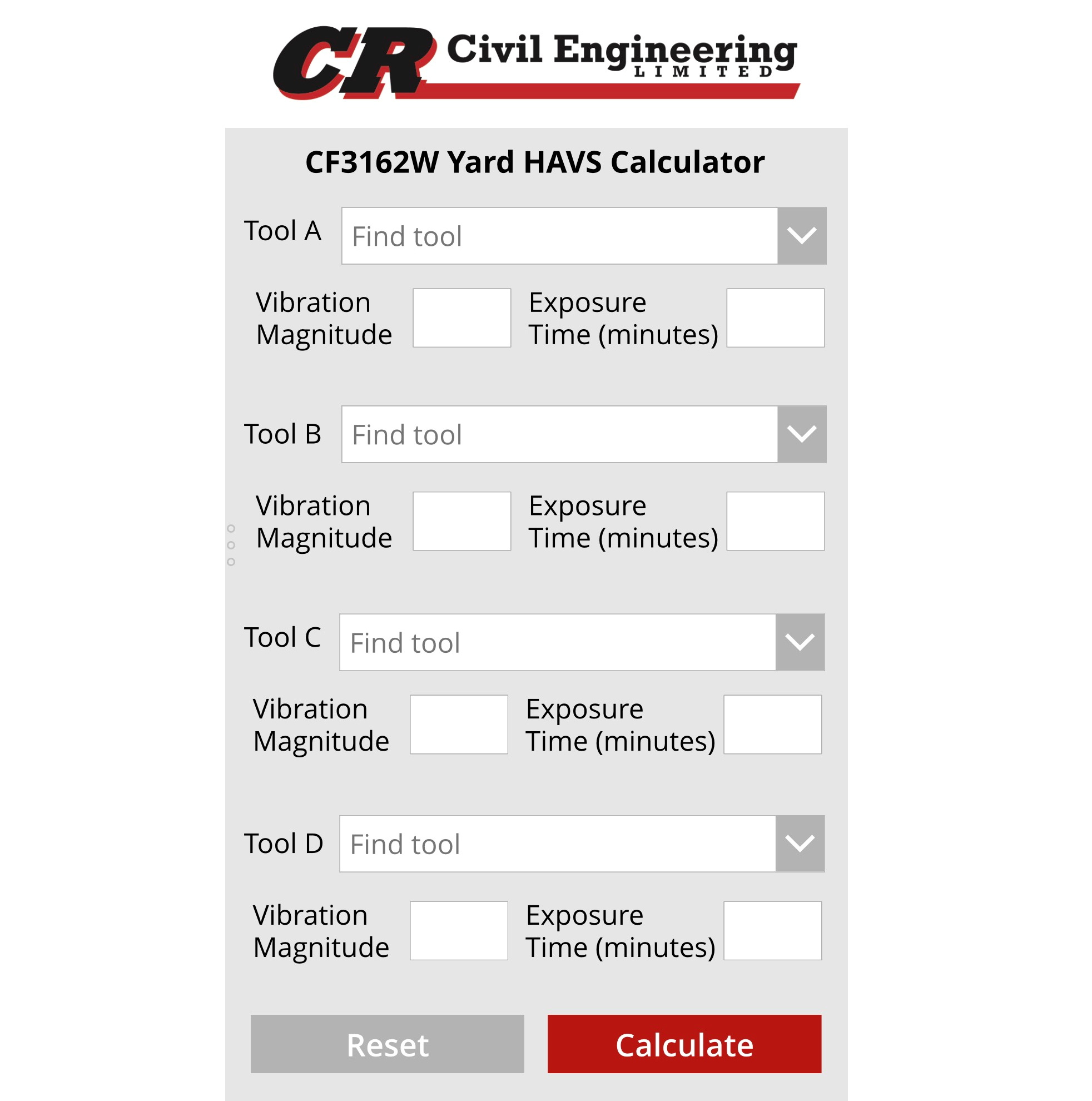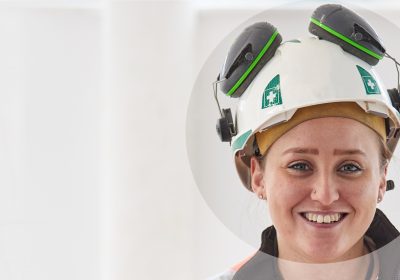Spotlight on… worker fatigue aims to raise awareness of the health and safety risks associated with fatigue and provides the industry with guidance for addressing this issue…
Examples of best practice
The Scheme aims to improve the image of construction through sharing examples of best practice with the industry. Below are a number of examples of best practice that have been witnessed by our Scheme Monitors on their visits, or that have been submitted directly to the Hub by registered sites, companies, and suppliers.
Construction Industry Helpline App
The Lighthouse Club Construction Industry Charity, who run the Construction Industry Helpline, launched an app in collaboration with COINS (a construction software firm) and Building Mental Health (an online information portal about mental health, also developed by the charity). The new Construction Industry Helpline app will be a free, confidential service aimed at providing essential information and guidance on wellbeing…
Bespoke Chill Out Room
Historically, this contractor has seen operatives taking naps and breaks in the change rooms to find a quiet space, therefore they wanted to provide them with a bespoke and specific place to rest and recharge. Research also shows that short naps and effective breaks can improve brain function, elevate moods, sharpen alertness, strengthen memory and lower blood pressure. With this…
Cold Cut Rebar
Following recent updates in the fire prevention legislation, the contractor are actively encouraging and working to eliminate the requirement for all hot works through the design phases. They have worked with the subcontractor to procure a hydraulic cordless rebar cutter that is spark-free and eliminates the requirement for hot works/permits. The cutter significantly reduces noise during the rebar cutting in…
Manoeuvring Heavy Steelwork using Rollers
Steelwork was required in various locations throughout this tightly compacted residential home, including the formation of a new lower ground floor, rear terrace and installation of a central ‘stability frame’. To help manoeuvre these steels weighing in at almost 400kg each into the building, industrial grade rollers on bearings were implemented. Steels were delivered by hi-ab, positioned on rollers, and…
Kone Site Flow
Kone Site Flow is a traffic analysis system which this contractor has implemented during construction to boost efficiency in the distribution of people and materials around the building via lifts and hoists to reduce waiting time and improve efficiency in vertical transportation up through the building. Each operative on site during induction is issued with a Kone Site flow sticker…
Solo-Gyps Drywall Attachment
The Solo-Gyps drywall attachment simplifies the positioning of plasterboard ceiling panels saving manpower and effectively allowing one operator to lift panels without assistance. This is ideal for interior fit-out projects and significantly reduces the risk of musculoskeletal injury and fatigue for installers. Plasterboard for ceilings have historically been raised by handed, while there have been some lifting aids and props…
Dobydo Robotic Arm
This contractor is the first in the county to use a robotic arm to perform work in the high-risk environments around the segment stacks and lift. A robotic arm performs two tasks when preparing the segments for ring building. Dobydo is the name given to the part of the robot that screws in the segment dowels and fittings. Krokodyl is…
Heavy Duty Scaffold Tube Transporter
This contractor has looked into opportunities to reduce the risk of back and other injuries from the manual handling of scaffolding components such as scaffold tubes. Through this research the contractor has recently purchased two trolleys specifically designed to carry scaffold tubes around sites and factories. This has been welcomed positively by the employees on the project. To find out…
Building Strength to Prevent Workforce Injuries
This initiative is focused on preventing repetitive strain injuries in construction which currently accounts for a third of all construction related injuries. The contractor has engaged with a former Team GB and current Red Bull Sport Strength & Conditioning coach to develop a programme specifically aimed at reducing repetitive strain injuries in the construction industry. The overall aim is to…
Spinal Assessments
Poor posture can lead to spinal and muscular issues, but it can also cause headaches, poor sleep, and digestive problems. There are also links between poor posture and anxiety levels, with there being a clear link between posture and how it can affect our mental health. With that in mind, looking after the posture of workers is very important. On…
Safe Handling of Surveying Equipment
Engineers can carry a lot of heavy surveying equipment whilst out on site. One of the heavier items they carry is a theodolite which can weigh up to 12kg. As this equipment is stored in a case, the weight cannot be spread across the body but is instead distributed to the one hand causing the body to twist when walking…
Angled Material Trolley Accessory
In the early stages of this project it was identified that the method for transporting 3 metre lengths of mechanical and electrical materials such as pipework, trunking, cable tray, Unistrut, cable basket etc. from the basement loading bay to the fit-out floors was a challenging task. This was because the designated goods lift is under 3 metres long. Therefore the…
Use of Ball Bearings to Manoeuvre Heavy Loads
Cement boards are used in various applications on the project such as being rendered for gas farm walls and soffits. The boards are drilled into for fixing, and over 1,400 holes are required. Previously, this was a laborious operation as the operative needed to lift and rotate the board to drill the holes. These boards weigh approximately 13 kg/m2 so…
Eliminating Harm through Rock Wheel Trencher
The traditional method of saw cutting trenches can be time consuming and expose workers to risks such as noise and flying debris as well as fatigue if carrying out the task over prolonged periods of night time closures. In order to minimise these risks, athe contractor trialed the use of a rock wheel trencher on their projecy and it significantly…
Crane Hook Manipulator
As a result of site constraints with a limited distance to the NWR fence, combined with their complicated façade installation process, they needed a specialist device for installing some of their façade components. They used ‘Alice’ – their hydraulic remote controlled crane hook attachment. This prevents the number of operatives having to work around a suspended load and can turn…
Providing Support to Employees and their Families
This contractor is providing free access to the Canada Life ‘WeCare’ app and website, plus AIG’s bereavement support helpline for all construction employees and their immediate family members. The Canada Life WeCare app is a service with access to a 24/7 online GP, mental health counselling, a get fit programme, plus legal and financial support as well as diet and…
Thermocouple to Assess Concrete Strength in Real Time
This contractor is using a thermocouple to assess concrete strength. The thermocouple is fixed by cable ties and then connected to the wireless transmitter. The contractor will then cast and pour the concrete and using the web portal view the results Using this method of concrete testing has benefits for the project which are: The requirement for manually making cubes…
Lateral Transport Unit
Due to the complex nature of manoeuvring heavy, pre-cast soffit slabs in a site with many logistical constraints and challenges, the project engineers researched into what they could use to facilitate the movement of the slabs, whilst also reducing the associated health and safety risks. The slabs are required to be moved between different levels and different columns which, is…
Mindfulness Development Workshop
This contractor have devised a staff wellbeing measure to ensure all staff have the access and opportunity to help them manage their day-to-day wellbeing. Research has highlighted that many people find practising mindfulness helps them become more aware of the present moment and can help them enjoy the world around them more and understand themselves better. The way people think…
Insight Timer
As an employer, the contractor has a duty of care to ensure that health, safety and wellbeing, and that of others, is not affected whilst at work. They also has a legal duty to manage the risks from fatigue, irrespective of a person’s willingness to work extra hours or preference for certain shift patterns or social reasons. They have implemented…
Fatigue Management Controls for 24 Hour Working
Major transport infrastructure projects often require periods of working around the clock during planned closures (e.g. on the rail network, motorways). This contractor recently executed a 9 day period of 24 hour working during a ‘blockade’ closure of the Network Rail East Coast Mainline. Various blockade specific controls were introduced around fatigue to protect workforce safety and wellbeing, including the…
Window Glazing Robots to Minimise Manual Handling
To install windows on this project they have been using Winlet glazing robots to minimise the manual handling involved by the operatives. The robots provide remote controlled lifting and weigh just 1800kgs with full counterweights, and can be used to operate across low load bearing floors. The machines use powerful vacuum lifters to hold glass and other loads safely. The…
Mood Meter
The coronavirus pandemic and lockdown has had a marked effect on people’s mental health. The Lack of social life and continued work had some impact on construction workers. Being at work most of the times, the contractor identified the need for creating support from colleagues and managers. They decided to introduce mood meter. Arriving onsite, workers are encouraged to take…
‘Spotlight on… worker fatigue’ follow-up article
In September 2019, the Scheme launched ‘Spotlight on… worker fatigue’ to raise awareness of this significant health and safety issue facing the industry. How can fatigue affect health and safety? Fatigue can slow reaction times, create lapses in judgement, reduce concentration and coordination, diminish cognitive ability and cause individuals to underestimate risk. In the construction industry, individuals can often endure…
Master Mover SM100+
The MasterMover is an electric tugging machine. The device was procured from the market and its attachment has been specifically designed and tested to fit the frame of the Portable Utility Cupboards (PUC’s). Familiarisation training has been delivered by supply chain to all PME operatives handling these units. The attachment was made specifically to move the portable utility cupboard on…
Individual Voting Pads
To engage better with the workforce and improve feedback, the EARPS team purchased a set of voting pads to use during extended SOS presentations and Stand-Downs. These voting pads allowed questions to be asked of the workforce and provide feedback on initiatives, site arrangement, and fatigue management. They are also used to keep our quarterly stand downs interactive by using…
Worker Fatigue Focus
As a company, Mark James Complete Building Services have been supporting the recent ‘Spotlight on… worker fatigue’ learning toolkit. We also recognise that mental health issues and fatigue can sometimes come hand-in-hand, and this is somethinhttps://staging.ccsbestpractice.org.uk/spotlight-on/spotlight-on-worker-fatigue/g we are focused to support our employees with. They launched their campaign with an online survey, which was sent via email to all our…
HAVS Calculator App
At CR Civil Engineering, we know how important it is to minimise workers exposure to Hand Arm Vibration Syndrome (HAVs) and how difficult it can be to calculate exposure if multiple tools are used in one shift. To help, we have developed a smartphone app which Site Managers and Foremen can use to make the calculation as simple as possible….
Rebar Mechanical Tying Gun
Bam Nuttall have implemented rebar mechanical tying guns to increase efficiency and significantly reduce repetitive strain injuries. The tying gun provides a solution to the physically demanding, monotonous and time-consuming work of manual tying. Tying rebar involves handling heavy materials, working in awkward positions, and repeating the same hand twisting motions over and over. All of this can lead to…
Health and Wellbeing
Morgan Sindall and its subcontractors all have strong beliefs regarding the wellbeing of the workforce and staff. As a result, during a sit down with our subcontractors, we all decided as a team to stop all work on Wednesdays between 9 and 10 am, and in this hour, only using phones for social purposes rather than taking work calls and getting…
Combatting Fatigue, Anxiety and Depression with SAD Lighting
At Robertson we believe that a healthy workforce is a happy workforce! We value our workforce and understand that mental health problems and fatigue can affect anyone at any time. We operate an open door policy where employees and subcontractors can talk to a manager or Mental Health First Aider in absolute confidence. We provide a free helpline that offers…
Hydraulic Punch Driver
The site are using a battery powered hydraulic punch driver. It has an aluminium head which is designed to rotate at 360 degrees. This enables the operator to use the punch in a confined space. This helps avoid injury as manual handling is reduced and there is no longer a need to use a jig saw within an awkward position….
Moodbeam Device for Mental Health and Wellbeing
‘Moodbeam’ devices are currently being trialled on this project. The aim of these wristband devices is to support meaningful conversations in relation to the user’s mental health and wellbeing. The device logs sleep and activity, and the user presses a yellow button on the device when feeling happy and a blue button when feeling unhappy. The device connects to an…
Mediation and Meditation
On The Broadway project, we are focusing on the wellbeing of all Multiplex staff and contractors working on our behalf. We have collectively been thinking of new ways to help manage stress and in doing so have took to mindfulness and how it can help in the workplace. We invited a guest speaker to help us learn meditation techniques as…
Fatigue Monitoring System
Considering the importance that the HSE places on fatigue and working excessive, along with our focus on Mental health, we decided to have Datascope create a way in which to record and clearly indicate the number of hours worked per operative per week. A report is then automatically created and sent to the Goodmans Fields management team to review on…
Mobile Site Accommodation
Mid 2018 saw GBM Demolition make the business decision to design and build a series of transportable site accommodation trailers. Each one features separate sleeping accommodation for up to five people, complete with TV, heating and individual en-suite bathrooms with showers, as well as a shared fully operational kitchen and mess facility. Each unit comes to site with the access…
Onsite Drivers’ Rest Station
We recognised that drivers within our supply chain were taking their breaks in vehicles which is not ideal! As we have enforced zero idling on our site, we decided to make a change by offering somewhere to relax while taking breaks or waiting for unloading. This has undoubtedly had a positive impact in the direct environment of the site, as…
Electric Wheelbarrows
Recently on one of our sites, operatives were challenged by the difficulties in renovating a historic Grade II listed building in London City Centre. The project had various environmental requirements that needed to be met, such as noise restrictions and air quality standards. Nevertheless one of the most challenging adversities was the size of the site, which required operatives to…
Morning Warm Up Exercises
At our Pontoon Dock site, we constantly try to improve the health and wellbeing of our workforce. We believe that we our obliged to provide our construction workers with the highest standards in terms of safety and working conditions. Using a variety of methods, we can make our jobs easier and preserve our safety. The warm up exercises in the…
Construction Industry Helpline App
The Lighthouse Club Construction Industry Charity, who run the Construction Industry Helpline, launched an app in collaboration with COINS (a construction software firm) and Building Mental Health (an online information portal about mental health, also developed by the charity). The new Construction Industry Helpline app will be a free, confidential service aimed at providing essential information and guidance on wellbeing…
Off Road Holding Area Collaboration
In 2015, 107 pedal cyclists and 186 pedestrians were killed or seriously injured on British roads in accidents involving at least one HGV. HGVs were involved in 25% of pedestrian fatalities and almost 60% of cyclist fatalities. According to the European Transport Safety Council (2001), indications have shown that driver fatigue is a contributing factor in approximately 20% of HGV…
Electronic Wellbeing Hub
GRAHAM have developed an online portal to manage their wellbeing programme more effectively, allowing employees to self-manage diagnostics, appointments and gain access to additional wellbeing support resources including videos on wellbeing subjects and access to national and local wellbeing services. Accessible through the intranet for staff and employees the GRAHAM Wellbeing Hub promotes key wellbeing messages to everyone, from the…
Phone Home Room
Mount Anvil has introduced a room on all our sites with free WiFi and a tablet if needed, to enable the workforce to contact their family whilst at work. This is to help combat stress and mental health issues related to those who work away from home and have minimal contact with their loved ones. These rooms have proved a…
Hi-Viz Jacket with Drinks Bottle
We have added a ‘Camelbak’ drinks bottle in the rear of the hi-viz for operatives so that they do not have to walk around the site looking for hydration. This is especially useful for traffic marshals who are on the go, who can quickly hydrate in the summer months, reducing the need for plastic bottles which are becoming a major problem…
Elevated Desks for Staff Wellbeing
In the site office, elevation desks were procured to ensure that it is possible for employees to work standing up for periods of the day. The benefits of this include increased wellbeing, flexibility for employees to adjust desk height individually and to work standing up. This will improve health in terms of reduced muscle pain from working in uncomfortable positions…
Readiband Technology for Fatigue
The health, safety and wellbeing of the BBMV workforce is of vital importance. BBMV at the Crossrail Whitechapel project worked in partnership with Fatigue Science Limited, as a part of a pilot to help enhance wellbeing in the workplace by looking at a sleep patterns in a sample of the workforce across all roles and shift patterns. The pilot combined…
Wellbeing Questionnaire
The Mace team at Grosvenor Crescent attempted to quantify wellbeing statistically. A wellbeing questionnaire was created. This questionnaire is used by the NHS to test Wellbeing in the UK and was created by the University of Warwick Medical School (Warwick-Edinburgh Mental Wellbeing Scale (WEMWBS)). The questionnaire involves 14 Questions with five response options available per question. Each response option generates…
Increasing the Standards of the Working Environment
The Greenwich Peninsula Upper Riverside welfare facilities have been designed to improve the standards and working environment on construction sites. Mace directors analysed a number of studies which show a correlation between the influence of working environment and staff productivity. This included examples from Google and Microsoft offices. This allowed the Mace team to identify measures that could be implemented…
Ecospot Boards
During bricklaying activities, there is a high risk of musculoskeletal injuries, due to the repetitive bending required to retrieve mortar from the mortar boards. The Ecospot is a bracket and mortar board that attaches to any standard scaffolding. It can be adjusted to suit any height that is comfortable for each individual bricklayer. These are currently in use on Mace’s…
Beating the Mental Health Stigma
The project has identified mental health as a key focus for 2017. To kick off the year in a positive light, presentations on mental health awareness were delivered to the workforce as part of our safe start following the Christmas period. The presentation reiterated how to identify the symptoms of stress and fatigue and how to foster positive mental health. Following…
Fatigue Wristband for Tunnelling Workforce
Worker fatigue poses a potential health and safety hazard, and can be detrimental to the overall health of the workforce. Fatigue can have similar effects to alcohol, slowing down reaction time, causing lapses in judgement, and impairing cognitive ability. This danger is particularly relevant to projects which involve tunnelling, as the long shifts and rotating day and night shifts put workers at greater…
Stress and Resilience Guidance
During periods of change and high demand, the Costain Skanska Joint Venture building Crossrail’s Paddington Station require their staff to be resilient and proactive about maintaining their wellbeing. The workplace has a duty of care to provide an environment that not only creates formal opportunities for wellbeing discussions, but actively encourages managers to discuss levels of stress and resilience with…
Managing Worker Fatigue
Worker fatigue should be acknowledged as a serious concern to health and wellbeing. A summary of what exactly worker fatigue is and the effects can be found here. Alike to all safety hazards on a construction site, worker fatigue and the risks associated with it not only effect the individual, but also those around them. The Causes Some of the…
What is Worker Fatigue?
The safety and wellbeing of a site’s workforce is a primary concern and must be properly monitored and managed. Amongst other common safety hazards, worker fatigue should not be something that is overlooked. “A state of perceived weariness that can result from prolonged working, heavy workload, insufficient rest and inadequate sleep.” – Office of Rail Regulation 2012 The Effects A construction…






























 A-one+ describes how it has devised a fatigue management plan, policies and preventative measures to prevent fatigue and to safeguard the health and wellbeing of all operatives on site.
A-one+ describes how it has devised a fatigue management plan, policies and preventative measures to prevent fatigue and to safeguard the health and wellbeing of all operatives on site. 


 Gym On Site explain how their stretch and flex programmes to the construction industry generate benefits both for the company and its workforce.
Gym On Site explain how their stretch and flex programmes to the construction industry generate benefits both for the company and its workforce. 













